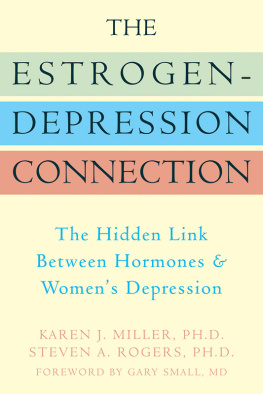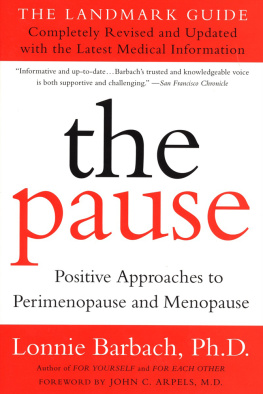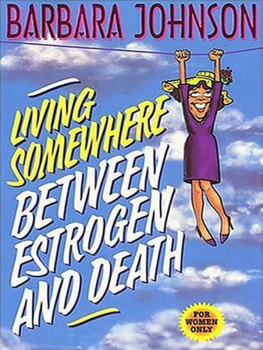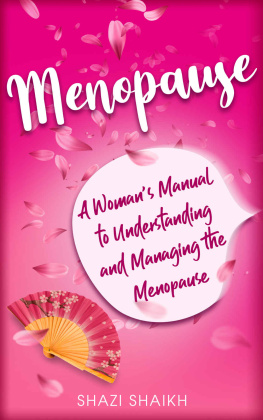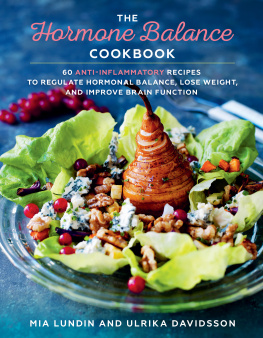CHAPTER 1
Estrogen & the Female Brain
I get PMS every month, so I know estrogen can affect my mood, but I had no idea that it might be related to my ongoing symptoms of depression. This is what we often hear from women in our therapy practice when we suggest the connection between estrogen and depression. Lisa was one of these women. When we first met her, she was thirty-nine years old and had been married for three years. With some sadness, she told us that she was reluctant to get married because she sees herself as moody and feels misunderstood, particularly when she is about to start her menstrual cycle. During these times, she often feels depressed and fatigued, has no desire to socialize, and feels out of control. She needs room to breathe and requires a flexible schedule at work in order to function at her best capacity during these periods.
After trying several things to treat her depression, she found some relief taking a combination of two antidepressants. When she initially thought about individual psychotherapy, she doubted a therapist would really understand how these symptoms fluctuate each month. Then Lisa heard us speak at a local seminar. She approached us and asked about a referral for therapy. She also asked about the possible connection between estrogen and depression in her own life.
As she began therapy, Lisa was primarily concerned with symptoms of depression, including sadness, fatigue, and insomnia, which would last for two or three hours each night. Her husband thought her symptoms were due to work-related stress, but this seemed too simplistic an explanation. Stress can contribute to depression, but it would not account for her fluctuating depressive symptoms each month. Antidepressants were not effective in easing her symptoms, so after some thought, we didnt feel it was appropriate to simply encourage her to continue the antidepressants without addressing the underlying emotional issues and the possible hormonal causes of her depression. We ended up recommending ongoing individual psychotherapy and combining her antidepressants with hormonal replacement.
Had we met Lisa forty or fifty years ago, we would have approached it differently. During that period, it was widely thought that estrogen only served a reproductive role. We now know more. There has been an explosion of research suggesting that the brain is greatly affected by estrogen. These effects are widespread, affecting learning and memory, sensitivity to pain, and emotional homeostasis. When we say homeostasis, we are talking about a state of balance, in this case, emotional. This is difficult to achieve given womens fluctuating hormone levels, particularly from puberty to menopause. When these hormone levels do not reach a balance, women are more at risk for developing depression. As scientists and researchers gradually came to understand the relationship between estrogen and depression, they began wondering if some depression in women was due to the role of estrogen in the female brain.
NOTE: We ask you as readers to please keep in mind that while the stories we will present in this book are based on actual women, they are composites of many women rather than a specific client or friend. All names are fictional.
What Is Estrogen?
Lisa thought she had a relatively good understanding of estrogen. Like many women, she gathered isolated slices of information about it from her mom, female friends, personal experience, and classes taken in high school or college. But as we worked with her, she was surprised to learn the ways that estrogen also influences the brains and moods of women.
As we share some of the same thoughts we explored with Lisa, it will be helpful for you to have an understanding of what estrogen is and how it impacts the brain. Put simply, estrogen is a female sex hormone that is primarily produced by the ovaries, although smaller amounts are also produced by a structure in the brain called the adrenal cortex. There are three naturally occurring forms of estrogen: estradiol, estriol, and estrone. We will discuss these specific forms of estrogen later in the book, but for the present time we will refer to them collectively as estrogen. While estrogens are present in both men and women, women have them in significantly higher quantities than men. These estrogens promote the development of female secondary sexual characteristics, such as breast development. They are also involved in controlling the menstrual cycle, which is why most oral forms of birth control contain estrogens. But the effect of estrogen begins even before birth.
Estrogen & Early Brain Organization
You know the old expression, Before you were a twinkle in my eye? Well, estrogen makes its first impact on brain development before a mother even realizes that shes going to give birth to a baby. These earliest effects are called organizational operations because they organize the architecture of the brain in a way that creates sex differences in our brains and behavior (Halbreich and Kahn 2001; Schechter 1999).
Imagine, for example, that a civil engineer is hired to build two subway systems, one for men and one for women. He needs different blueprints to build each of these systems to fit the different needs of men and women. In a similar way, the brain of the prenatal infant works as an engineer who needs blueprints to modify subway tracks to fit a male or female body. These blueprints come from the unborn infants hormones and represent the organizational operations that modify the brains structure and neural circuitry. This blueprint, so to speak, differentiates the female from the male body, brain, and neurodevelopment, particularly in ways that influence mood and behavior, such as by determining the way in which the molecules that receive estrogen are positioned in the brain, which can contribute to estrogens impact on mood.
Estrogen Receptors
Imagine the subway system again. Both the female and male tracks have frequent stops where passengers are able to use the phonethat is, they can communicate a message. Many of these messages will likely involve statements about how they are feeling. Some messages may indicate to friends or family that they are feeling happy, others sad, and others nervous or simply ambivalent.
There are molecules in our brain called estrogen receptors that act in a similar way. They are organized like these subway stops, but they are densely packed into various regions of the brain that greatly influence mood and behavior. One of the areas with a high density of these estrogen receptors in women is the limbic system. The limbic system is the switchboard of our internal subway and is responsible for emotional processing (Lee and McEwen 2001; Soares, Poitras, and Prouty 2003). The functions of several brain structures in this complicated switchboard are summarized in table 1.1 (OConnell 2005; Wieck 1996):

Because these structures have a high density of estrogen receptors, they are going to be easily impacted by changes in estrogen. The estrogen-dense structures listed in this table govern sleep, motivation, resilience, and mood, areas in which depressive symptoms can be expressed. Because, unlike men, women are likely to experience fluctuations in estrogen throughout their life span, they may be more biologically predisposed toward a greater risk of depression. This predisposition is based not only on the activity of estrogen prior to birth, but also on some effects that occur after birth.
Estrogen & the Brain After Birth
Estrogen exerts a second and different type of effect on the female brain after birth and throughout a womans life on what are called
Next page
